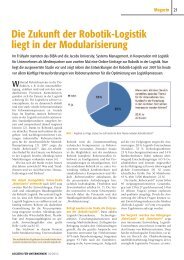Jahresbericht 2006 - Biba - Universität Bremen
Jahresbericht 2006 - Biba - Universität Bremen
Jahresbericht 2006 - Biba - Universität Bremen
Erfolgreiche ePaper selbst erstellen
Machen Sie aus Ihren PDF Publikationen ein blätterbares Flipbook mit unserer einzigartigen Google optimierten e-Paper Software.
MSA<br />
The IP Multimedia Subsystem (IMS)<br />
is a Next Generation Networking (NGN)<br />
architecture for telecommunications services<br />
standardised by the 3rd Generation<br />
Partnership Project (3GPP) and fixed services<br />
standardised by the ETSI Telecoms<br />
& Internet converged Services & Protocols<br />
for Advanced Networks (TISPAN) group.<br />
IMS was defined using Internet<br />
protocols standardised by the Internet<br />
Engineering Task Force (IETF). Specifically,<br />
IMS builds on the IETF Session Initiation<br />
Protocol (SIP) with a few extensions standardised<br />
by 3GPP and running over the<br />
Internet Protocol (IP).<br />
IMS aims to provide access to services<br />
to both stationary and mobile users,<br />
regardless of the type of network they<br />
currently roam. Both packet-switched<br />
and circuit-switched telecommunications<br />
systems are supported and any combination<br />
of IMS and Internet users can setup<br />
a session between them.<br />
Furthermore, IMS was designed not<br />
only as a ubiquitous service delivery<br />
platform, but also as an integration<br />
platform for both current and future<br />
services, both telecommunications and<br />
Internet services. IMS merges the Internet<br />
with the mobility paradigm for application<br />
developers by enabling the use of<br />
cellular technologies to provide ubiquitous<br />
access and Internet technologies to<br />
provide appealing services.<br />
The IMS architecture for communication<br />
services consists of a number of<br />
components; (a) basic IMS communication<br />
services like push-to-talk over cellular,<br />
IMS Messaging, charging and multimedia<br />
telephony supported by clients in the<br />
terminal as well as SIP application servers<br />
in the network (b) enabling services like<br />
presence and SIP Push. All of these are<br />
basic elements in a solution which provides<br />
end-user services.<br />
Provision of complex multimedia<br />
services composed of individual service<br />
components requires aggregation logic<br />
to support the creation and execution<br />
of such services, as well as to guarantee<br />
prevention of unwanted and unforeseen<br />
side effects (often referred to as feature<br />
interaction) between them. Given the<br />
complexity of such aggregations and<br />
both the amount of work as well as the<br />
possibility of unforeseen side effects<br />
it is required to foresee a method for<br />
automating this process as strongly as<br />
possible.<br />
The main objectives of Project „Multi-<br />
Service Architecture for the Next Generation<br />
of telecommunication services“ (MSA)<br />
is to investigate existing service composition<br />
approaches towards resolving<br />
these issues and implementing a service<br />
composition prototype for SIP services<br />
based on the J2EE Architecture.<br />
Eugen Freiter<br />
27









